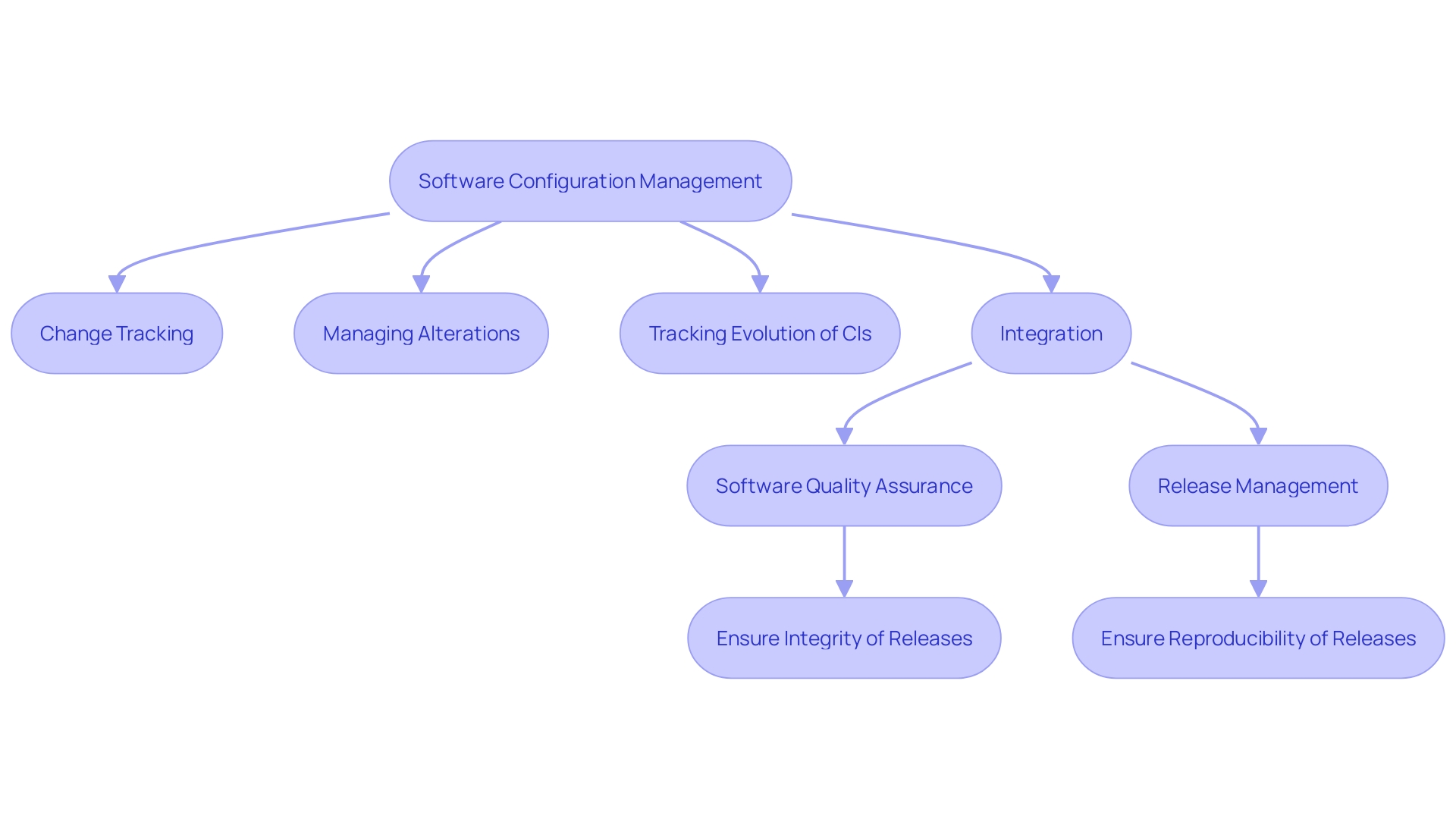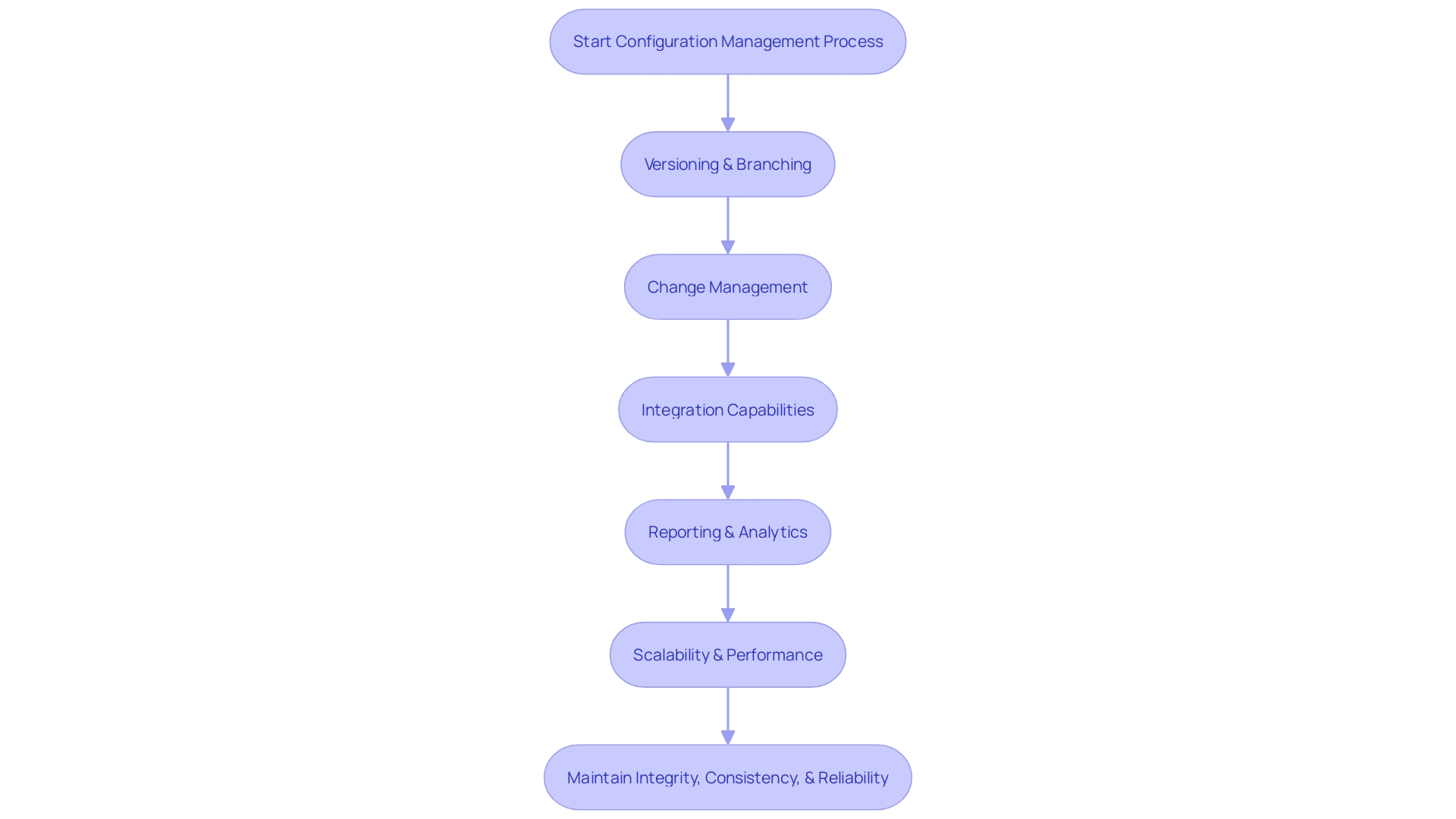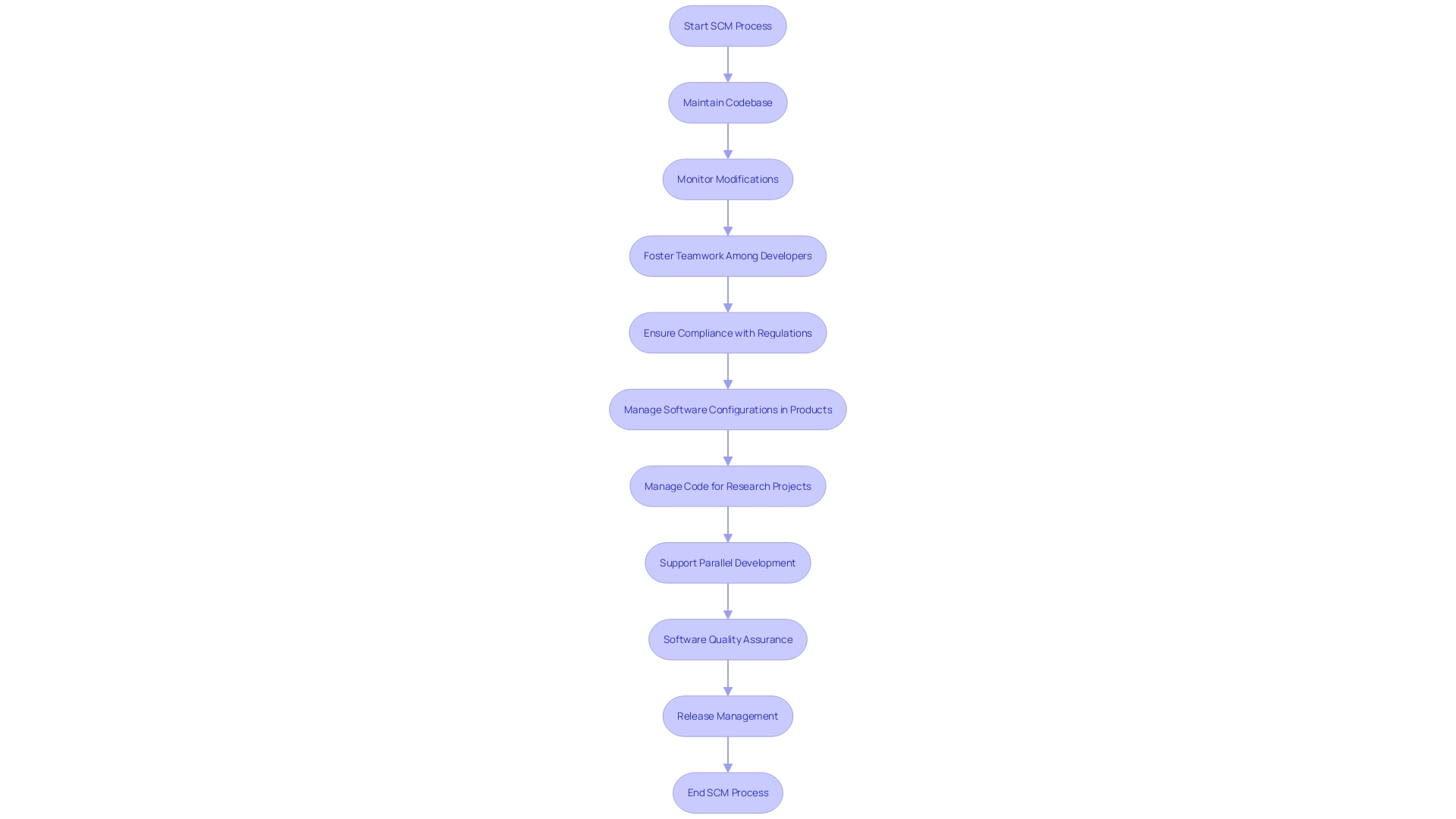Introduction
Software Configuration Management (SCM) is a vital discipline that guides the evolution of software artifacts throughout their development lifecycle, ensuring the integrity and reliability of software products. At its core, SCM offers a transparent view of software configurations, managing alterations in a systematic manner. By adopting standard practices, SCM facilitates robust change control measures, parallel development, and reproducibility of software releases.
This article explores the benefits of SCM tools, key functions they provide, top software configuration management tools, how they enhance collaboration, best practices for SCM, and the importance of version control and automation. Real-world applications and examples demonstrate the pivotal role of SCM in various industries, supporting software development, IT operations, manufacturing, and research institutions. By implementing effective SCM tools, organizations can optimize their software engineering processes and deliver high-quality software efficiently.
What is Software Configuration Management?
Software Configuration Management (SCM) transcends mere change tracking; it is an intricate discipline that guides the evolution of software artifacts across their entire development lifecycle and beyond into product release. At the core of SCM is the ability to offer a transparent view of software configurations at any given instance, effectively managing alterations in a systematic manner. This control mechanism ensures the integrity of software products, delineating the process of their construction from the foundational elements such as source code, libraries, and ancillary components.
SCM is instrumental in distinguishing and managing unique iterations of these software artifacts, denoted as configuration items (CIs), and meticulously tracks their evolution over time. The adoption of standard practices in SCM facilitates robust change control measures, fosters a conducive environment for parallel development, and guarantees the reproducibility of software releases.
As illustrated by the journey of an organization in 2017, the transition from manual provisioning to leveraging Infrastructure as Code with Terraform exemplifies the transformative impact SCM can have. Such a shift not only simplifies and standardizes the configuration of infrastructure but also scales operations with minimal exertion, highlighting SCM's critical role in contemporary software engineering.
SCM's significance extends into its integration with software quality assurance and release management, anchoring it as a cornerstone of engineering best practices. This synergy is essential in realizing the software engineering process's overarching objective: to efficiently, reliably, and cost-effectively conceive, design, implement, test, deploy, and maintain software systems.
The discourse on SCM in the Software Engineer Book of Knowledge (SWEBOK) reinforces this perspective, emphasizing the establishment of functional and physical baselines as pivotal reference points in a product's lifecycle, akin to the philosophical musings of Theseus' ship. These baselines facilitate a comparative assessment of changes, underscoring SCM's vital role in maintaining the product's performance and integrity throughout its evolution.
Recent industry insights, such as those from the 2024 Docker State of Application Development Report, continue to underscore the dynamic nature of software development and the ever-growing importance of SCM in navigating this landscape. As SCM practices evolve, they remain intrinsically linked to the pulse of software engineering, propelling the industry towards excellence in a world increasingly reliant on complex, high-quality software systems.

Benefits of Software Configuration Management Tools
Software configuration management (SCM) tools are integral to the effective and efficient delivery of software in today's fast-paced and complex development environments. These tools provide pivotal benefits:
-
Version Control: SCM tools are fundamental for tracking and managing changes to the codebase, ensuring teams can revert to prior states as necessary and maintain a history of modifications for analysis and recovery purposes.
-
Enhanced Collaboration: Centralizing the code repository, SCM tools enable multiple developers to collaborate seamlessly, even when working on different features or fixes, thus optimizing concurrent development efforts.
-
Traceability: A comprehensive record of changes made to software components is maintained, facilitating easier identification of issues' origins, and providing a clear overview of project progression.
-
Stability and Reliability: By implementing standardized processes and workflows, SCM tools contribute significantly to the stability and reliability of software systems, minimizing the risk of errors and inconsistencies that could arise from manual interventions.
-
Efficient Deployment: Automation capabilities within SCM tools streamline the processes of building, testing, and deploying software, which accelerates release cycles and enhances overall productivity.
SCM is an essential discipline as highlighted in the Software Engineer Book of Knowledge (SWEBOK), ensuring control over software artifacts throughout their lifecycle. It is tightly intertwined with software quality assurance, release management, and engineering best practices, assisting teams in managing changes effectively and maintaining the integrity of software products. As software systems grow in complexity, the role of SCM in coordinating engineering teams and preserving the software's integrity becomes increasingly crucial, enabling parallel workstreams and mitigating the introduction of inconsistencies.
Key Functions of Software Configuration Management Tools
Software configuration management (SCM) tools are essential for maintaining the consistency, traceability, and integrity of software products throughout their lifecycle. These tools offer key functionalities that streamline the development process and enhance collaboration among teams.
- Version Control: SCM tools are integral for version control, providing a systematic approach to manage modifications, track revisions, and seamlessly integrate code contributions from various developers. Such tools are crucial for maintaining a historical record of changes, enabling teams to revert to previous states if necessary and collaborate effectively.
- Configuration Identification: By identifying and documenting the distinct components of software, SCM tools ensure that accurate versions are utilized during each stage of deployment, bolstering the reliability of software releases.
- Configuration Control: The ability to enforce control over changes is another vital function of SCM tools. They ensure that modifications are authorized, properly documented, and subjected to the necessary approvals, thereby safeguarding the software from unauthorized alterations.
- Configuration Status Accounting: SCM tools maintain a comprehensive log of the configuration history, offering insights into the evolution of the software system and facilitating traceability of every alteration made over time.
- Configuration Audit: To comply with industry standards, policies, and regulations, SCM tools enable organizations to conduct thorough audits of their software configurations. This ensures that the software adheres to the prescribed guidelines and maintains its quality.
Incorporating SCM into an organization's workflow can significantly reduce the risk of defects and enhance the quality of software releases. As highlighted in the Software Engineer Book of Knowledge (SWEBOK), SCM is a cornerstone of software engineering best practices. It supports procedures for change control, facilitates parallel development, and contributes to the recreation of releases.
Moreover, news from the tech sector, such as the launch of Piiano's code analyzer Flows, underscores the ongoing advancements in SCM tools. These innovations aim to provide developers with more sophisticated capabilities for tracking and protecting sensitive data throughout the development process. As such, selecting a robust SCM tool, like Chef, which is designed for tackling complex tasks, becomes a strategic decision for organizations aiming to optimize their DevOps workflows.
Ultimately, the right choice of SCM tools can empower IT management and application lifecycle management (ALM), ensuring that software systems are developed, deployed, and maintained with high standards of speed, stability, and scalability.
Top Software Configuration Management Tools
Selecting the right configuration management tools is pivotal for enhancing automation and performance in software projects. Git stands out as a distributed version control system, renowned for its robust branching and merging features. Its distributed nature allows for better handling of large projects with speed and efficiency. Subversion (SVN) offers a centralized approach to version control, ensuring a stable and reliable management environment for software code.
Mercurial is another distributed version control system, praised for its simplicity and straightforward workflow, making it an attractive option for teams that value ease of use. Perforce shines in scenarios requiring scalability; it is a version control and collaboration platform that can handle the demands of large enterprise projects without sacrificing performance. IBM Rational ClearCase provides a comprehensive suite of configuration management tools that cater to complex development settings, ensuring that all changes are tracked and managed effectively.
Microsoft Team Foundation Server (TFS) integrates version control with project management and collaboration tools, making it a seamless choice for teams already invested in the Microsoft ecosystem. These tools are essential in a managed services market that is growing rapidly in regions such as North America, where businesses are seeking strategic solutions to optimize their IT operations for enhanced efficiency, scalability, and cost-effectiveness.
These configuration management tools are integral to the DevOps ecosystem, automating the software development lifecycle (SDLC) and bridging gaps between development, operation, and quality assurance. By incorporating continuous integration (CI), continuous delivery (CD), infrastructure as code (IAC), and other automation practices, organizations can achieve faster delivery, improved accuracy, and a reduction in overhead. According to the Linux Foundation's research, companies across various industries are adopting these cloud-native techniques, signaling a shift towards more automated and efficient software development processes.
How Software Configuration Management Tools Enhance Collaboration
Software Configuration Management (SCM) is a critical facet of the software development life cycle, enhancing the collaboration among development teams and bolstering the integrity of the final product. By centralizing the code repository, SCM tools provide a single source of truth for code storage and management, accessible to all stakeholders involved. This centralization is essential, as it ensures that team members are working with the most current and consistent versions of the software components, thereby reducing the likelihood of conflicts or integration issues.
The enablement of concurrent development is another cornerstone of SCM, allowing multiple developers to work on the same codebase without overwriting each other's work. This parallel development accelerates the development process and improves coordination, as highlighted in the Software Engineer Book of Knowledge. Furthermore, SCM's role in facilitating code reviews cannot be overstated. By incorporating tools for peer review, SCM enables developers to provide constructive feedback, recommend enhancements, and maintain high code quality standards.
Moreover, SCM streamlines the workflow with predefined processes that guide the team through efficient collaboration. These workflows ensure that every change undergoes a thorough review and approval process before integration, thus safeguarding the codebase's integrity. Such standard practices are not only pivotal for change control but also for enabling a parallel development process that is crucial for modern software engineering.
Quality assurance, as underscored by the SWEBOK, is intimately connected to SCM. As software complexity grows, with intricate interdependencies between components, SCM offers the necessary control and visibility to manage changes effectively. Formal SCM processes are known to reduce defects and rework by preventing unauthorized changes that could lead to inconsistencies. Teams can branch and merge code changes confidently, knowing that their efforts are supported by controlled and well-documented processes.
In the context of Theory W, the success of a software project relies on creating winning conditions for all participants. SCM is instrumental in this regard, as it provides a framework for managing the software process and aligning it with the project's goals. By establishing a reliable SCM system, project managers can ensure that the development team, stakeholders, and end-users are all beneficiaries of a quality software product, reflecting the Theory W principle of mutual success.
In summary, SCM is not just a tool for managing code; it's a comprehensive discipline that empowers teams to deliver high-quality software efficiently. By centralizing code repositories, enabling concurrent development, facilitating code reviews, and streamlining workflows, SCM plays a pivotal role in the modern software development process.
Best Practices for Software Configuration Management
Leveraging best practices for software configuration management (SCM) is essential for organizations aiming to enhance the efficiency and stability of their technology infrastructure. Key strategies include:
- Establishing Clear Processes:
- Define standardized procedures for version control, change management, and release management.
-
Ensure these processes align with organizational standards and regulatory requirements.
-
Regular Backups:
-
Implement consistent schedules for backing up code repositories to safeguard against data loss due to hardware failures or other unexpected events.
-
Access Control:
-
Apply stringent access controls to restrict software configuration changes to authorized personnel only.
-
Automating Builds and Deployments:
-
Employ automation tools to minimize human error and increase efficiency in build and deployment operations, thereby streamlining the software delivery process.
-
Conducting Audits:
- Regularly perform audits on software configurations to verify compliance and adherence to best practices.
According to the Software Engineer Book of Knowledge (SWEBOK), SCM provides critical visibility into software configurations at any point in time, managing changes in a controlled manner and maintaining the integrity of the product. It is a discipline that identifies unique versions of software artifacts as configuration items (CIs) and meticulously tracks their evolution.
A case study featuring Dectar, a cybersecurity firm, underscores the importance of dedicated documentation in reducing the workload on support teams and maintaining timely and structured release notes across multiple languages.
In the realm of DevOps, which represents a significant shift in software development philosophy, the automation of core SDLC stages through practices like continuous integration (CI), continuous delivery (CD), and infrastructure as code (IAC) is fundamental. This automation not only decreases overhead but also accelerates time-to-market, as highlighted by a guide on the top configuration management tools for DevOps.
Configuration management tools such as Chef stand out for their ability to address complex tasks and contribute to the agile management of technology resources. Such tools should offer an intuitive interface, meet budget and licensing needs, and robustly support infrastructure as code.
As the software landscape evolves, with advancements like OpenAI's SearchGPT in the pipeline, the role of SCM in ensuring product consistency and navigating the intricacies of software dependencies becomes ever more pivotal.

Importance of Version Control and Automation
The intersection of version control and automation represents a pivotal enhancement in the realm of software configuration management. Version control systematically manages changes to the software's codebase, allowing teams to collaborate with agility and ensuring that every modification is accounted for and reversible. Automation complements this by streamlining workflows, diminishing the scope for manual errors, and promoting a consistent output across development cycles.
M&T Bank's journey epitomizes the transformative impact of these technologies. With their initiative to implement Clean Code standards, they have exemplified how version control and automation can uphold the integrity and compliance of banking software amidst a digital upheaval.
Similarly, Terraform's tale of evolution from manual provisioning to defining Infrastructure as Code (IAC) illustrates the scalability and standardization automation brings to the table. It highlights how such tools not only facilitate the management of infrastructure but also make it reproducible and less prone to human error.
Moreover, the bold strategy employed by GOV. UK to trial-run live components of their website underpins the confidence that version control and automation can install within an organization. This approach allowed them to concentrate on key aspects, reach significant milestones, and unveil minor issues that could have impeded the launch.
As noted by Christopher Condo of Forrester Research, the surging demand for software across various sectors underscores the critical role of version control systems. They are not just a luxury but a necessity in a fast-paced market that values swift product delivery.
In line with the principles outlined in the Software Engineer Book of Knowledge (SWEBOK), these practices are fundamental to managing changes throughout a product's lifecycle. They maintain product integrity by tracing the construction from source code to libraries, and other components, and are integral to quality assurance, release management, and overall best practices in software engineering.
Ultimately, the synergy of version control and automation is a cornerstone in modern software development, driving efficiency, reducing risk, and fostering a culture of excellence within tech-driven enterprises.

Common Features of Effective Software Configuration Management Tools
Effective configuration management tools are indispensable for maintaining the integrity, consistency, and reliability of software products. They offer a range of features designed to streamline the development process and bolster software quality. Key features include:
-
Versioning and Branching: These tools provide robust mechanisms for version control, enabling developers to manage multiple code versions and create branches for concurrent development efforts. Such capabilities allow for tracking of changes over time, aligning with established standards for change control, and support the recreation of past releases.
-
Change Management: A structured approach to handling changes is paramount. This includes managing change requests, approvals, and ensuring that all modifications are well-documented. These processes are closely tied to software quality assurance and release management, reinforcing the product's stability and preventing unauthorized changes that could lead to defects.
-
Integration Capabilities: The ability to seamlessly integrate with other development tools, such as Integrated Development Environments (IDEs), issue tracking systems, and CI/CD pipelines, is crucial. This interconnectivity enhances visibility and control, facilitating a cohesive environment for managing complex software configurations.
-
Reporting and Analytics: Insightful analytics and reporting features provide teams with the ability to monitor key metrics, identify process bottlenecks, and implement improvements. This data-driven approach to configuration management aids in ensuring that the development process is efficient and effective.
-
Scalability and Performance: As software projects grow and teams become more distributed, the need for tools that can efficiently handle large codebases and support multiple users without compromising performance becomes critical.
By employing these fundamental features, organizations can reduce the incidence of rework and defects, enable their teams to work in parallel, and maintain the high quality of their software products throughout their lifecycle.

Real-World Applications and Examples
Across diverse sectors, software configuration management (SCM) tools are pivotal in maintaining the integrity and performance of software systems. In the realm of software development, these tools are indispensable for maintaining codebases, monitoring modifications, and fostering teamwork among developers. This is evident in organizations like Sombra, where a proactive approach to business challenges in the IT sector is adopted, bolstering a culture of innovation and collaboration among over 250 experts in Eastern Europe.
IT departments rely on SCM tools to ensure that software configurations are stable, reliable, and compliant with regulations, much like the services provided by Persistent Systems, which recently introduced a novel open source maintenance service. This service is designed to keep open source software up-to-date with patches, bug fixes, and the latest releases, thereby ensuring continuous business operations.
In the manufacturing sector, SCM tools are harnessed to manage software configurations embedded in products, guaranteeing consistency and high quality. This aligns with the growing trend of increasing device value, with average selling prices now exceeding $440, underscoring the strategic importance of implementing advanced features to maintain competitiveness in key markets.
Research institutions are no different in their use of SCM tools. They utilize these tools for managing code for research projects, which promotes collaboration and ensures the reproducibility of results. This is crucial in a dynamic environment where, as articulated by software expert Lynn Greiner, the unique perspective of blending IT expertise with business acumen can significantly address the challenges faced by companies.
In essence, SCM tools are integral to various industries, enabling them to navigate the complexities of modern software development and maintenance. As described in the Software Engineer Book of Knowledge (SWEBOK), SCM is a disciplined approach to managing changes throughout the software lifecycle, ensuring product integrity and tracking the construction from source code to libraries. These tools support parallel development, enable change control, and play a vital role in software quality assurance and release management.

Conclusion
Software Configuration Management (SCM) is a vital discipline that ensures the integrity and reliability of software products throughout their lifecycle. SCM tools streamline the development process, minimize errors, and accelerate release cycles through automation. These tools offer benefits such as version control, enhanced collaboration, traceability, stability, and reliability.
Key functions of SCM tools include version control, configuration identification, configuration control, configuration status accounting, and configuration audit. Top SCM tools like Git, Subversion (SVN), Mercurial, Perforce, IBM Rational ClearCase, and Microsoft Team Foundation Server (TFS) integrate version control with project management and collaboration.
SCM tools enhance collaboration by centralizing the code repository, enabling concurrent development, and facilitating code reviews. They streamline workflows, ensure thorough review and approval processes, and support software quality assurance. Best practices for SCM include clear processes, regular backups, access control, automation of builds and deployments, and audits.
Effective SCM tools offer features such as versioning and branching, change management, integration capabilities, reporting and analytics, and scalability and performance. Real-world applications of SCM tools can be seen in software development, IT, manufacturing, and research institutions, where these tools enable collaboration, compliance, and high-quality software systems.
In conclusion, SCM is a vital discipline that ensures software integrity and reliability. SCM tools streamline development, enhance collaboration, and maintain software quality. By implementing effective SCM tools and following best practices, organizations can optimize their software engineering processes and deliver high-quality software efficiently.
Streamline your software development process with SCM tools!




